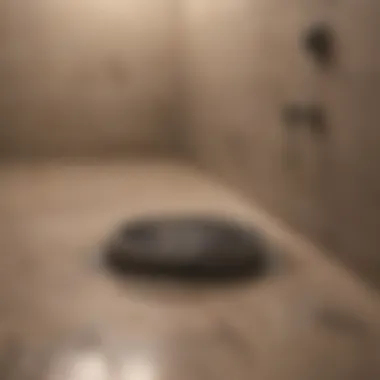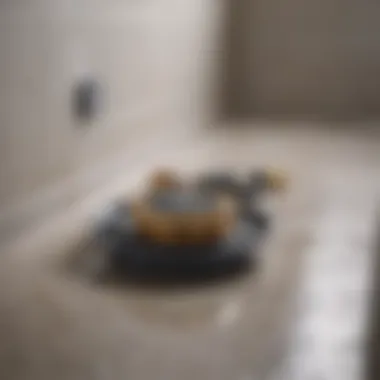Tackle Persistent Shower Drain Clogs Effectively


Intro
Shower drain clogs are a common nuisance that many homeowners face. They can disrupt daily routines and create unnecessary stress. Understanding what causes these persistent clogs and how to effectively address them is essential. This guide aims to provide clarity about shower drain issues from their origins to practical solutions. Taking proactive measures can help maintain a smooth drainage system.
Home Features
Persistent clogs can happen in any home. However, certain design features may exacerbate drainage issues, making it vital to consider these elements during home improvement projects.
Architectural Considerations
Some homes are designed with easier drainage in mind. For instance, sloped floors direct water towards the drain efficiently. In contrast, a flat surface can lead to stagnation and clogs. Understanding your home’s flow is crucial.
Unique Drain Designs
Modern shower designs sometimes include unique drain placements or styles. For example, linear drains can offer a sleek appearance but may require more maintenance. Homeowners should choose a drain type that suits both aesthetics and functionality while minimizing clog risks.
Understanding the Causes of Clogs
Clogs typically arise from a combination of hair, soap scum, and other debris. It's important to understand the key factors contributing to these blockages.
Hair Accumulation
Hair is one of the leading culprits in shower clogs. Whether long or short, hair tends to accumulate in the drain over time. Regular cleaning and the use of drain covers can help manage this issue.
Soap and Product Residue
Commercial soaps and shampoos contain various chemicals. These can build up in the pipes, combining with other debris and forming thick masses. Switching to natural alternatives may reduce buildup.
Foreign Objects
Sometimes, small objects accidentally fall into the drain, contributing to clogs. Always be cautious of what you bring into the shower to limit these occurrences.
Preventive Measures
Prevention is often easier than remedying an existing clog. Here are some strategies to keep drains clear:
- Regular Cleaning: Dedicate time weekly to clean the drain and surrounding areas.
- Use Drain Covers: Install a cover to catch hair and larger debris before it enters the drain.
- Conduct Routine Inspections: Check for early signs of slow drainage and address them promptly.
Effective Solutions for Unclogging
When clogs do occur, there are various methods to resolve them. Here are some techniques:
Plunger Method
Using a plunger can create pressure to free blockages. Make sure to cover any overflow drains to focus the pressure on the clog.
Baking Soda and Vinegar
This natural solution is effective for minor clogs. Pour baking soda followed by vinegar down the drain, and let it sit before flushing with hot water. It can provide a deeper clean.
Professional Help
In cases of persistent or severe clogs, consider consulting a plumber. Their expertise can help identify and fix underlying issues that may not be easily visible.
"Regular maintenance can save time and money in the long run."
The End
Understanding the full scope of shower drain clogs is essential for any homeowner. From identifying the causes to implementing preventive measures and solutions, proactive management can lead to a smoother, hassle-free experience. Remember to respect the unique features of your home and consider them when looking at drainage solutions.
Understanding Shower Drain Clogs


Understanding shower drain clogs is crucial for homeowners and design enthusiasts alike. This issue often disrupts daily routines, making it annoying to manage a blocked drain. Knowing the factors that contribute to clogs can help prevent them, saving time and money on repairs.
The Mechanics of Shower Drains
Shower drains function through a straightforward design. Water flows down the drain via gravity, assisted by a sloped pipe. The drain itself typically consists of a strainer that captures larger debris, while smaller particles can pass through. However, over time, various substances can accumulate, hindering this flow. Understanding how these components work is essential for resolving persistent clogs effectively.
- Drain Structure: The drain features a cover and a waste pipe. Each part plays a role in maintaining free-flowing water.
- Benefits of Proper Drain Function: A well-functioning shower drain prevents flooding and unpleasant odors.
- Considerations: Regular checks and swift action upon noticing issues can prevent a minor inconvenience from becoming a serious problem.
Common Types of Clogs
There are various types of clogs that can affect shower drains. Awareness of these types can aid in prevention and resolution.
- Hair Accumulation: One of the most significant contributors to clogs. Hair can bind with soap scum and other debris, forming a tight blockage.
- Soap Scum: Soap residue can adhere to the drain walls, creating a sticky layer that traps additional debris.
- Mineral Deposits: Hard water can lead to mineral buildup in the pipes, also restricting water flow.
- Foreign Objects: Items that accidentally slip down the drain, such as small toiletries or even toys, can create instant jams.
"Being proactive about drain care can significantly prolong the life of your plumbing system."
Understanding these common culprits is the first step in maintaining clear and functional shower drains.
Identifying Causes of Clogged Shower Drains
Understanding the causes of clogged shower drains is essential to any effective drainage management strategy. Homeowners often face recurring issues that stem from a variety of factors. By pinpointing the root causes, you can address the problem more efficiently and prevent further complications. Not only can this save time and financial resources, but it also enhances the functionality of your home.
When it comes to maintaining clean shower drains, awareness of common issues can empower individuals to act proactively. Taking the time to learn about how clogs occur is the first step towards effective management. Below, we explore three main contributors to clogged shower drains.
Hair and Debris Accumulation
One of the primary culprits behind shower drain clogs is the accumulation of hair and other debris. Hair falls into the drain regularly, especially in showers used for grooming routines. This simple act can lead to significant blockages over time. Hair has a tendency to tangle, catch soap residue, and combine with other particles, creating a dense mass that obstructs water flow.
To reduce the chances of hair and debris accumulation, consider implementing preventive measures:
- Use a drain hair catcher: Devices specifically designed to trap hair can significantly reduce the amount of hair that reaches the drains.
- Routine cleaning: A quick removal of collected hair from the drain after each shower can prevent build-up.
- Educational emphasis: Teach family members and guests the importance of keeping the shower area clean.
If hair clogs have already occurs, utilize tools like a drain snake to reach deeper blockages, ensuring full water flow is restored.
Soap Scum Build-Up
Another factor contributing to clogged showers is the build-up of soap scum. Soap scum forms when fatty acids in soaps and shampoos react with minerals in water. This substance can accumulate inside pipes, ultimately narrowing the passage for water. The impact is often more pronounced in areas with hard water, where mineral deposits are higher.
To combat soap scum build-up effectively:
- Select appropriate products: Consider using biodegradable soaps and shampoos, as they may produce less soap scum.
- Regular maintenance: Running hot water through the drains occasionally helps dissolve and flush away soap residue.
- Routine cleaning: Using vinegar or baking soda as natural cleaners can help break down soap residue build-up, reducing the need for heavy-duty chemicals.
By addressing soap scum proactively, you can extend the lifespan of your plumbing and avoid numerous headaches in the future.
Foreign Objects in the Drain
Foreign objects often pose a serious threat to the integrity of shower drain systems. Items such as toys, cotton swabs, or small pieces of personal care products can inadvertently make their way into the drain. Once lodged in the pipe, these items can impede water flow, leading to clogs.
To minimize the likelihood of foreign objects entering the drain:
- Supervise children: Ensure that young children are monitored while in the shower to prevent toys from being dropped in.
- Educate about drain obligations: Clarify the importance of keeping non-drain-safe items out of the shower area.
- Regular checks: Regularly inspect the shower area for items that could potentially fall into the drain.
In some instances, a more involved solution may be required. If these foreign objects have already created blockages, consider using a plumber’s snake to retrieve them or, when necessary, call in a professional.
"Prevention is always better than cure. Simple adjustments can save homeowners from the stress of frequent plumbing issues."
By clearly identifying the causes of clogged shower drains, you create a foundation upon which preventive and corrective actions can be built. Understanding the specifics of hair, soap scum, and foreign objects aids in developing a comprehensive approach to maintaining clear and functional drainage systems.
Signs of a Clogged Shower Drain
Recognizing the signs of a clogged shower drain is crucial for maintaining a functional and pleasant bathing environment. Ignoring the early warnings can lead to more severe plumbing issues and costly repairs. By being vigilant, homeowners can mitigate the risks related to persistent clogs and ensure smooth water flow in their showers.
Slow Drainage


One of the most common indicators of a clogged shower drain is slow drainage. When water takes a long time to disappear after you turn off the shower, this should raise immediate concern. Slow drainage suggests that debris, hair, or soap scum is building up in the pipes, restricting water flow.
- Immediate Action: If the water is noticeably pooling at your feet, consider taking action right away. You may want to try using a plunger or employing a drain snake to dislodge some of the obstruction.
- Long-Term Perspective: If slow drainage keeps happenning, it might indicate a deeper issue. Regular monitoring is essential to prevent future plumbing complications.
Unpleasant Odors
Another significant sign of a clogged shower drain is the presence of foul smells. Unpleasant odors usually result from decomposing organic materials stuck in the drain, such as hair, lint, and soap residue. If you notice a bad smell emanating from the shower, it likely signals that an accumulation is brewing below the surface.
- Health Considerations: The bacteria resulting from stagnant water or decomposing material can cause hygiene issues. It’s important to regularly clean your shower to avoid both unpleasant smells and potential health risks.
- Solution Tip: A mixture of vinegar and baking soda can help alleviate odors while also breaking down some build-up.
Gurgling Noises
Gurgling noises while the shower is in use are another clear signal of clogging. When water struggles to flow through a drain, air pockets form, creating unusual sounds as air escapes through the obstruction. This can be aggravating and indicates that your drainage system requires immediate attention.
- Identifying Severity: Gurgling sounds can vary in intensity. A faint gurgle might not be alarming, but loud sounds should not be ignored. They often suggest a significant blockage that might affect other drains in your home.
- Action Steps: For minor gurgling, consider running hot water to clear the passage. If this does not resolve the issue, further investigation into the plumbing system may be necessary.
Important Note: Early detection of these signs can prevent more significant plumbing failures and save you from costly repairs in the future. Pay attention to your shower drain and address any changes right away.
Being aware of these signs will help homeowners keep their showers running smoothly. Recognizing the patterns of slow drainage, unpleasant smells, and gurgling noises not only ensures efficiency but also contributes to the overall hygiene of one's living space.
Preventive Measures for Clogs
Preventive measures for clogged shower drains are critical in maintaining the functionality of your plumbing system. These strategies not only alleviate the frustration of recurrent clogs but also promote longer-lasting drainage performance. Addressing prevention can save homeowners time and money in the long run. Effective measures focus on minimizing the accumulation of debris and tackling common culprits that cause blockages, as well as enhancing the general upkeep of shower drain systems.
Regular Cleaning and Maintenance
Regular cleaning and maintenance is the cornerstone of effective drainage systems. Establishing a routine cleaning schedule helps to prevent the buildup of hair, soap scum, and other substances. It is advisable to clean the shower drain at least once a month.
Methods for maintaining a clean drain include:
- Removing Hair: After each shower, use a simple tool to remove hair from the drain cover. This small task can significantly reduce blockage risks.
- Washing Down the Drain: Use hot water mixed with vinegar to flush out soap scum. This mixture helps to break down residues without using harsh chemicals.
The cumulative effect of these practices can enhance the performance of your drain, contributing to its longevity.
Installation of Drain Covers
Installation of drain covers is another effective preventive measure. These accessories act as barriers that trap hair and larger debris before it can enter the drain. A well-fitted drain cover can effectively minimize the risk of clogs and ease maintenance efforts. Additionally, regular inspection and cleaning of drain covers ensure they function optimally.
Benefits of Drain Covers:
- Cost-Effective: A small investment can prevent costly plumbing repairs.
- Easy to Install: Many drain covers are designed for quick and easy installation, requiring no professional help.
Use of Eco-Friendly Drain Cleaners
The use of eco-friendly drain cleaners is an important aspect of preventive measures. Traditional chemical cleaners can be harmful to both the environment and plumbing systems. Switching to eco-friendly options reduces toxic byproducts while effectively keeping drains clear. These products often use natural ingredients that dissolve buildup without causing damage to pipes.
In summary, prioritizing these preventive measures is key to ensuring a smoothly functioning shower drain. Regular maintenance routines, installation of protective covers, and a commitment to using safer cleaning solutions can drastically reduce the likelihood of future clogs.
Immediate Solutions for Clogs
Dealing with a clogged shower drain can bring inconvenience to your daily routine. Understanding immediate solutions is crucial for maintaining bathroom functionality. These solutions can be handy when water accumulates and fails to drain properly. You can remedy these situations using readily available tools and techniques, helping to restore flow instantly. The significance of these immediate strategies lies in their ability to provide a quick fix without extensive downtime.
Plunging Techniques
Plunging is often the first line of defense against shower drain clogs. This method involves using a plunger to apply pressure that can dislodge the obstruction. Begin by ensuring that there is enough water in the shower to cover the rubber part of the plunger. Stand the plunger over the drain and press down firmly, then pull up quickly. Repeat this action several times to hopefully loosen whatever is blocking the pipe. It’s essential to maintain a good seal around the drain for maximum effect. If done correctly, this technique can effectively clear many minor clogs.
Chemical Drain Cleaners
In cases where plunging fails, you might consider chemical drain cleaners. These products contain powerful substances that can dissolve hair, soap scum, and other debris. Follow the manufacturer's instructions carefully when using these products to avoid damage to your plumbing. While effective, it is essential to remember that overuse can lead to detrimental effects on your pipes. Safety precautions are necessary, such as wearing gloves and ensuring proper ventilation. Rely on these cleaners sparingly, as they are more of a short-term solution.
DIY Tools and Methods
There are various DIY tools and methods available to address persistent shower drain clogs. Here are a few effective techniques to consider:


- Hair Catcher: Installing a hair catcher in the drain can prevent hair accumulation.
- Baking Soda and Vinegar: This natural solution can be effective. Pour half a cup of baking soda followed by half a cup of vinegar. Let it sit for 30 minutes, then rinse with hot water.
- Snake Tool: A plumber's snake can reach deep into the pipes and dislodge clogs. Insert the snake into the drain and twist it around to grab the obstruction.
Using these tools can help you manage clogs more independently and reduce the need for professional assistance. Employ these methods and apply them based on the level of severity you are facing with the drain blockage.
When to Seek Professional Help
Understanding when to seek professional help is crucial for homeowners facing persistent shower drain clogs. While many minor issues can be resolved through DIY methods, some problems require the expertise of a qualified plumber. Knowing the right time to call a professional can prevent further damage and save money in the long run.
Persistent Clogs
Persistent clogs are a clear sign that a problem is beyond standard remedies. If you find yourself frequently plunging or using chemical drain cleaners with little to no success, it is advisable to seek professional assistance. Several factors might contribute to such persistent issues, including:
- Build-up of Hair and Debris: Over time, even if one maintains regular cleaning, a significant accumulation of hair and debris can create a blockage that simple methods cannot clear.
- Old or Damaged Pipes: Aging plumbing systems may have structural weaknesses that exacerbate clogs. A professional can identify if the pipes are corroded or misaligned.
- Complex Drainage Systems: Some drainage systems are more intricate and require specialized knowledge to address the clogs effectively.
Ignoring persistent clogs can lead to more severe plumbing issues, including water damage and mold growth. It is better to address these problems early with the help of a specialist.
Potential Pipe Issues
Potential pipe issues often go undetected until they cause significant problems. If you suspect that a clog results from issues within the pipes, such as breaks or build-up in drainage lines, do not hesitate to call a plumbing professional. Consider the following signs:
- Unusual Noises: Gurgling or bubbling sounds can be an indication of trapped air within the plumbing system, suggesting blockage.
- Slow Drainage Across Multiple Fixtures: If more than one drain in the house is slow, it might imply a broader main drain issue.
- Frequent Back-ups or Overflowing: If you notice instances of back-ups or the toilet overflow, the underlying problem could lie within the main plumbing line.
Engaging a plumber for suspected pipe issues can help identify the root cause of clogged drains. They have diagnostic tools that allow for a thorough inspection of the plumbing system, such as camera inspections. This can provide peace of mind and ensure a practical solution is applied.
Seek professional help early to prevent extensive damage and costly repairs.
Long-Term Solutions for Clogged Drains
Ensuring that shower drains remain clear in the long run is crucial not just for functionality, but also for maintaining the overall health of your plumbing system. Long-term solutions vastly outpace quick fixes. While plungers and chemical cleaners may offer immediate relief, they do not address the root causes of persistent clogs.
The benefits are multifaceted. For one, regular maintenance and the right upgrades can save homeowners time and money spent on frequent professional drain cleaning. Additionally, addressing potential issues proactively can prevent further damage to plumbing, which might lead to costly repairs down the line.
Considering these factors, homeowners should contemplate the long-term approach that fortifies their drainage systems against future complications.
Pipe Inspection and Maintenance
Conducting regular pipe inspection and maintenance is fundamental for preventing future clogs. Homeowners often overlook the significance of this practice, focusing instead on immediate issues. However, proactively checking for blockages or weaknesses in the plumbing can save time and resources.
- Utilization of CCTV Technology: Employing camera technology allows homeowners to visually inspect the inside of pipes. This technique identifies cracks, buildup, or other defects that may not be outwardly visible. Such insights inform decisions on maintenance or repairs effectively.
- Routine Cleaning: Regular cleaning of pipes reduces the accumulation of hair and soap scum that usually leads to clogs. Schedule a cleaning at least once a year to maintain optimal flow.
- Identify Problem Areas: During inspections, take note of sections of the plumbing that contribute to frequent clogs. Address these areas directly, whether through preventive measures or necessary repairs.
Upgrading Plumbing Fixtures
Older plumbing fixtures can contribute to drainage problems significantly. Upgrading to modern fixtures often resolves persistent issues associated with clogs. Consider the following:
- High-Quality Showerheads: Investing in better showerheads with improved flow rates can minimize the amount of debris that enters the drain.
- Advanced Drain Designs: Drains equipped with special features, such as hair-catching technology, can prevent hair from clogging the pipe.
- Water-Efficient Toilets and Faucets: Installing water-efficient versions can reduce water wastage and help maintain proper pressure in the system, supporting effective drainage.
"Preventive maintenance paired with smart upgrades can significantly enhance the longevity of your plumbing system."
By integrating these long-term solutions, homeowners not only combat current issues but also take substantial steps towards a more reliable plumbing system.
End
In this article, we have dissected the issue of persistent shower drain clogs, addressing their causes, preventative measures, and viable solutions. Understanding these factors not only empowers homeowners but also aids design enthusiasts in maintaining their living spaces effectively. The gravity of this topic lies in its direct impact on household functionality and comfort.
Recap of Key Points
- Common Causes of Clogs: Hair, soap scum, and foreign objects prominently feature in the majority of clogs. Recognizing these components allows for targeted preventive measures.
- Preventive Techniques: Regular cleaning, the installation of drain covers, and the use of eco-friendly drain cleaners can significantly mitigate clogging issues.
- Immediate Solutions: Knowing how to effectively use plunging techniques, chemical drain cleaners, and other DIY methods provides homeowners with quick fixes while waiting for professional help.
- Professional Assistance: When clogs become persistent or if underlying pipe issues are suspected, seeking a licensed plumber is crucial.
- Long-Term Solutions: Regular pipe inspections and possibly upgrading plumbing fixtures can provide a more permanent resolution to recurring problems.
The insights shared throughout this article aim to equip individuals with actionable strategies, enhancing their overall living experience.
Importance of Regular Maintenance
Regular maintenance is not just a precaution; it is a necessity for the longevity and efficiency of your shower drainage system. Over time, hair, soap, and other debris can accumulate if not regularly managed. This buildup can result in slow drainage, unpleasant odors, and eventual clogs. Scheduling periodic inspections and cleaning can help to avoid these issues entirely.
Here are key benefits of regular maintenance:
- Cost-Effective: Prevention is less expensive than repairs. Addressing minor issues can save significant amounts in potential damages and emergency plumbing services later.
- Enhanced Hygiene: Routine cleaning reduces the risk of odors and encourages a healthier bathing environment.
- Increased Home Value: Well-maintained systems are a noticeable aspect of a home that can positively influence its market value.
By adhering to a maintenance schedule, homeowners not only improve their immediate living conditions but also ensure a functional and efficient shower drainage system for years to come.



